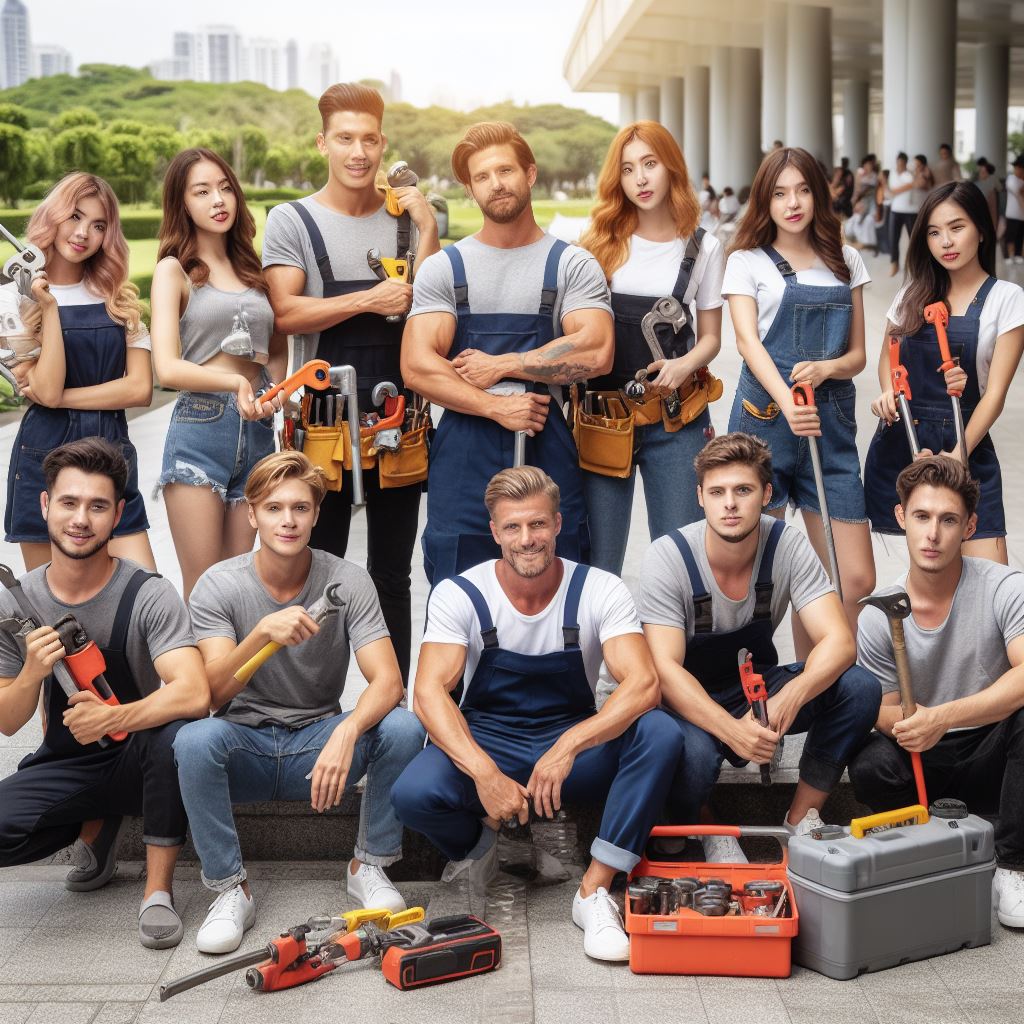Introduction
Plumbing in America has undergone significant historical evolution, playing a crucial role in sanitation and infrastructure.
Throughout history, plumbing in America has evolved from basic systems to advanced technologies, ensuring improved hygiene and comfort.
From humble beginnings, American plumbing emerged in the early 18th century, adapting European techniques.
In the 1800s, cast iron pipes replaced wood, transforming plumbing’s durability and reliability.
The Civil War spurred innovations, with brass and copper plumbing gaining prominence in American households.
Post-war, mass urbanization demanded efficient plumbing, leading to the birth of the first indoor bathrooms.
As the 20th century dawned, galvanized steel became the industry standard, revolutionizing water distribution.
World War II saw the rise of plastic pipes, a lightweight alternative that changed the plumbing landscape forever.
The 1960s introduced copper tubing, offering corrosion resistance and flexibility, further advancing plumbing technology.
Environmental concerns in the 1970s birthed water-saving fixtures, altering the public’s perception of water consumption.
The late 20th century witnessed the emergence of PEX, a flexible plastic piping material, simplifying installation processes.
In the 21st century, smart plumbing technologies have taken center stage, offering unprecedented control and efficiency.
From wooden pipes to smart systems, the historical evolution of plumbing in America reflects continuous innovation and adaptability.
Plumbing in Ancient Civilizations
Ancient civilizations had developed remarkable plumbing systems to meet their growing needs.
Overview of early plumbing systems in ancient civilizations
- In Mesopotamia, the earliest known plumbing systems were made of clay.
- These systems had pipes that carried water to houses and public establishments.
- Egyptians created complex irrigation networks using canals and water locks.
- They also had indoor plumbing with copper pipes and drainage systems.
- Plumbing in ancient Greece involved elaborate aqueducts and public bathhouses.
- Rome took plumbing to new heights with their impressive aqueducts and sewer systems.
Examples of notable plumbing advancements in Mesopotamia, Egypt, and Rome
- Mesopotamians developed the world’s first known flush toilets using water pressure.
- They also had intricate clay drainage pipes to remove wastewater from homes.
- Egyptians built complex irrigation systems to support agriculture along the Nile River.
- They constructed canal networks to distribute water for farming and daily use.
- Additionally, Egyptians used copper and bronze pipes for indoor plumbing in palaces.
- Romans invented the concept of urban sanitation by building extensive sewer systems.
- They designed aqueducts to transport clean water to populated areas.
- Rome’s public baths and toilets featured an impressive water supply and drainage system.
- Using gravity, the Romans created sewers that emptied into nearby rivers or the sea.
- They even had lead pipes to distribute water throughout the city.
Ancient civilizations paved the way for modern plumbing systems with their innovative techniques.
Stay tuned for the next section, where we will explore the plumbing advancements during the Middle Ages.
Read: Future Outlook: Predicting US Construction Industry Trends
Plumbing in Colonial America
Introduction of plumbing techniques by European settlers
During the colonial era, European settlers brought with them their knowledge and expertise in plumbing.
Early plumbing systems in colonial houses and buildings
Colonial houses and buildings initially had basic plumbing systems that relied on gravity and hand-pumped water.
- Wooden pipes were commonly used, carved out from logs and connected using joints made of animal bladders or hemp.
- As the colonies grew, lead pipes became more popular due to their durability and flexibility.
- Water sources were usually rivers or wells located nearby, and water was manually transported to the buildings.
Challenges and limitations of plumbing in colonial times
Plumbing in colonial America came with a set of challenges and limitations that affected its development.
Materials scarcity
Finding suitable plumbing materials was often difficult, leading to the use of creative alternatives.
Transform Your Career Today
Unlock a personalized career strategy that drives real results. Get tailored advice and a roadmap designed just for you.
Start NowLack of copper and iron forced settlers to rely on wood and lead pipes.
However, lead pipes posed health risks due to lead contamination.
Limited infrastructure
The lack of advanced infrastructure hindered the expansion of reliable plumbing systems.
Plumbing was primarily available in urban areas, while rural regions typically had no access to such systems.
Colonial towns had communal wells, but internal plumbing was a luxury reserved for the rich.
Primitive drainage systems
Colonial plumbing had basic drainage systems that lacked sophistication.
Typically, wastewater was disposed of through outdoor pits or cesspools, leading to sanitation issues.
In some cases, waste was simply dumped onto the streets, causing pollution and foul odors.
Water conservation
The scarcity of water required colonists to prioritize water conservation techniques.
Water was used sparingly and reused whenever possible.
As a result, bathing and laundry were infrequent and considered a luxury.
Limited fixtures and appliances
Colonial plumbing systems lacked the variety of fixtures and appliances seen today.
Indoor plumbing fixtures were basic, consisting of wooden or metal tubs and simple faucets.
Toilets were rare, and chamber pots were commonly used as a substitute.
Despite these challenges, plumbing in colonial America served as a foundation for the future development of plumbing systems.
The knowledge and techniques brought by European settlers laid the groundwork for future advancements.
The limitations faced during this era highlighted the need for improved infrastructure and sanitation measures.
In short, plumbing in colonial America was characterized by the introduction of European techniques, basic systems in houses and buildings, and various challenges and limitations.
Despite these obstacles, it paved the way for the evolution of plumbing, leading to the sophisticated systems we have today.
Read: Mental Well-being: Addressing Stress in Construction Work

Industrial Revolution and Plumbing Technology
Impact of the Industrial Revolution on the plumbing industry:
- Mass production and urbanization led to increased demand for plumbing services.
- New technologies and machinery improved efficiency and speed of plumbing installations.
- Increased wealth and disposable income allowed for more elaborate plumbing systems in homes and public buildings.
- Plumbing became recognized as a necessary part of modern infrastructure.
Development of water supply and sewage systems
- The need for clean water and proper waste disposal became a priority in rapidly growing cities.
- Engineers and city planners developed centralized water supply systems to meet the increasing demand.
- Public health concerns drove the establishment of sewage systems to prevent the spread of diseases.
- Scientists and engineers collaborated to create efficient water treatment and filtration methods.
Introduction of cast iron pipes and other innovative materials
- Cast iron pipes replaced wooden ones, reducing the risk of leaks and improving durability.
- Brass and copper became popular materials for plumbing fixtures due to their resistance to corrosion.
- Lead pipes were commonly used but later phased out due to health hazards.
- Plastic pipes, such as PVC and CPVC, emerged as cost-effective alternatives to traditional materials.
The Industrial Revolution reshaped America’s plumbing industry, fueled by rising mass production and urbanization.
Demand for plumbing surged, and plumbers became vital in supplying water and constructing sewage systems for expanding cities.
New technologies enhanced plumbing efficiency, enabling elaborate systems in homes and public buildings, as Americans’ increasing wealth facilitated investments in improved infrastructure.
Recognized as crucial for public health and safety, plumbing saw a transformative era, highlighted by notable developments in water supply and sewage systems.
Clean water and waste disposal became urban priorities, leading engineers and city planners to establish centralized water supply systems meeting growing demands.
Efforts to prevent diseases from improper waste disposal resulted in efficient sewage networks, supported by innovative water treatment methods.
Transform Your Career Today
Unlock a personalized career strategy that drives real results. Get tailored advice and a roadmap designed just for you.
Start NowThe Industrial Revolution brought material advancements, with cast iron pipes replacing wooden ones, reducing leaks and enhancing durability.
Brass and copper gained popularity for fixtures due to corrosion resistance, but lead pipes’ health hazards led to their phased-out.
Plumbing evolved with plastic pipes becoming cost-effective alternatives. PVC and CPVC pipes, affordable and easy to install, revolutionized the industry.
This era marked a pivotal point in American plumbing history, shaping the industry’s foundations with increased demand, advanced systems, and innovative materials.
Read: The Journey: Becoming a Licensed Plumber in the USA
Plumbing in the 20th Century
Advancements in plumbing technology and infrastructure
- The 20th century brought significant advancements in plumbing technology and infrastructure.
- Innovations such as improved pipe materials, water heaters, and sewage treatment systems revolutionized plumbing.
- Copper and galvanized steel pipes replaced cast iron, resulting in more durable and efficient plumbing systems.
- The introduction of polyvinyl chloride (PVC) pipes in the mid-20th century further improved plumbing installations.
- Water pressure regulators, backflow preventers, and thermostatic mixing valves ensured better control over water flow and temperature.
- Plumbing fixtures also saw tremendous improvements, with the development of efficient toilets, faucets, and showers.
- The availability of hot and cold running water became a standard feature in most residential and commercial buildings.
Introduction of indoor plumbing in American households
- Prior to the 20th century, indoor plumbing was a luxury only accessible to the wealthy few.
- However, in the early 1900s, indoor plumbing started becoming more common in American households.
- The introduction of modern sewer systems and water supply networks facilitated this transition.
- Rising standards of living and awareness of sanitary conditions contributed to the demand for indoor plumbing.
- Homes were retrofitted or built with bathrooms and kitchens equipped with sinks, toilets, and shower/bath combinations.
- Access to clean, running water and proper sewage disposal became essential for public health and hygiene.
- Indoor plumbing dramatically improved the quality of life, convenience, and sanitation for the general population.
Role of regulations and standards in ensuring public health and safety
- The introduction and widespread adoption of indoor plumbing necessitated the establishment of regulations and standards.
- Plumbing codes were developed to ensure that plumbing systems met safety, health, and performance criteria.
- Government agencies and professional organizations played a crucial role in establishing and enforcing these codes.
- Regulations covered aspects such as pipe materials, pipe sizing, drainage systems, venting, and cross-connection prevention.
- Plumbing inspections became a standard practice to ensure compliance with regulations and standards.
- Regular maintenance and repair of plumbing systems were emphasized to prevent water contamination and other hazards.
- By adhering to plumbing regulations, public health was safeguarded, reducing the spread of waterborne diseases.
Basically, plumbing in the 20th century witnessed significant advancements in technology, the widespread introduction of indoor plumbing in American households, and the establishment of regulations to ensure public health and safety.
These developments transformed the way people lived, providing access to clean water and hygienic sanitation.
The continuous improvements in plumbing systems continue to enhance the quality of life for individuals across America.
Modern Plumbing Practices and Innovations
Overview of current plumbing systems and practices
- Plumbing systems in modern America are much advanced compared to historical times.
- Water supply and sewage disposal play crucial roles in contemporary plumbing systems.
- Pipes made of materials like copper, PVC, and PEX are commonly used for water distribution.
- Flexible plastic pipes and seamless fittings enhance the efficiency and durability of plumbing systems.
- Improved techniques in pipe joining, such as soldering and solvent welding, ensure secure connections.
- Pressure valves, water meters, and backflow preventers are vital components of modern plumbing systems.
- Modern plumbing practices prioritize hygiene, safety, and convenience in residential and commercial buildings.
- Plumbers follow strict guidelines and regulations to ensure compliance with plumbing codes and standards.
- Emerging technologies like digital monitoring systems provide real-time data on plumbing conditions and usage.
- Advancements in plumbing design and installation result in more efficient and reliable water delivery systems.
Sustainable plumbing technologies and water conservation efforts
- Water scarcity and environmental concerns drive the adoption of sustainable plumbing technologies.
- Low-flow fixtures, such as toilets, faucets, and showerheads, reduce water consumption without compromising functionality.
- Greywater recycling systems collect and treat water from sinks, showers, and laundry for irrigation or toilet flushing.
- Rainwater harvesting systems capture and store rainwater for non-potable uses, reducing reliance on municipal water supplies.
- Dual-flush toilets offer different flushing options, using less water for liquid waste and more for solid waste.
- Water-efficient irrigation systems, like drip irrigation, minimize water wastage in landscaping.
- Sustainable plumbing practices aim to reduce water usage and promote water conservation in homes and businesses.
- Government initiatives and green building certifications encourage the adoption of sustainable plumbing technologies.
- Education and awareness programs highlight the importance of water conservation and sustainable plumbing practices.
- Plumbing professionals play a crucial role in promoting and implementing sustainable plumbing solutions.
Examples of recent plumbing innovations and trends in America
- Smart plumbing systems integrate technology to enhance efficiency and control water usage.
- Smart faucets and showers regulate water flow and temperature, promoting water conservation.
- Leak detection devices and automatic shutoff valves prevent water damage and wastage caused by leaks.
- Touchless technology, like motion-sensor faucets and toilets, minimize contact and improve hygiene.
- Smart irrigation systems monitor weather conditions and soil moisture to optimize watering schedules.
- Water purification systems provide clean and safe drinking water directly from the tap.
- Plumbing fixtures with antimicrobial properties inhibit the growth of bacteria and promote sanitation.
- Heat pump water heaters use renewable energy sources to heat water, reducing energy consumption.
- Hybrid water heaters combine traditional and tankless technologies for efficient water heating.
- Plumbing innovations continue to evolve as the industry strives for sustainability, efficiency, and water conservation.
Modern plumbing practices in America have witnessed significant advancements in both technology and sustainability.
Current plumbing systems prioritize efficiency, safety, and water conservation.
Sustainable plumbing technologies, such as low-flow fixtures and greywater recycling systems, play a crucial role in reducing water consumption.
Additionally, recent innovations like smart plumbing systems provide greater control, convenience, and hygiene.
As the plumbing industry continues to evolve, the focus remains on creating more efficient and eco-friendly solutions for the future.
Read: Top Plumbing Schools and Training Centers in the US
Conclusion
Recap of the historical evolution of plumbing in America
In the early days, plumbing systems were simple, using wooden or clay pipes to transport water.
As time went on, cast iron and lead pipes became popular, but health concerns led to the introduction of copper and galvanized steel pipes.
The invention of indoor plumbing in the late 19th century revolutionized hygiene and comfort in American homes.
The integration of sewage systems and the introduction of modern materials like PVC have further improved plumbing systems in America.
Reflection on the importance of plumbing in modern society
Plumbing plays a crucial role in our daily lives, providing clean water for drinking, cooking, and bathing, as well as removing wastewater effectively.
It ensures our health, sanitation, and comfort, contributing to the overall quality of life.
Transform Your Career Today
Unlock a personalized career strategy that drives real results. Get tailored advice and a roadmap designed just for you.
Start NowModern society heavily relies on efficient plumbing systems to maintain hygiene and prevent the spread of diseases.
Final thoughts on the future of plumbing and potential advancements
The future of plumbing appears promising with potential advancements in technology.
With the rise of smart homes, plumbing systems can be integrated with artificial intelligence and sensors, allowing for better monitoring and efficient water usage.
Additionally, there is a growing focus on sustainable plumbing solutions, including rainwater harvesting systems and water-efficient fixtures.
The industry’s ongoing commitment to innovation ensures that plumbing will continue to evolve for the betterment of society.
[E-Books for Sale]
The Big Book of 500 High-Paying Jobs in America: Unlock Your Earning Potential
$19.99 • 500 High-Paying Jobs • 330 pages
Explore 500 high-paying jobs in America and learn how to boost your career, earn more, and achieve success!
See All 500 High-Paying Jobs of this E-Book
1001 Professions Without a Degree: High-Paying American Jobs You Can Start Now
$19.99 • 1001 Professions Without a Degree • 174 pages
Discover 1001 high-paying jobs without a degree! Unlock career tips, skills, and success strategies for just $19.99!




